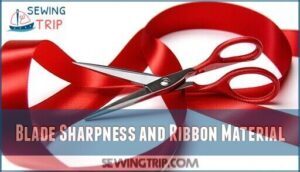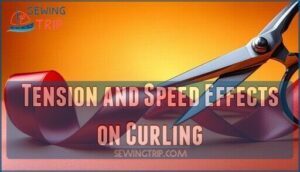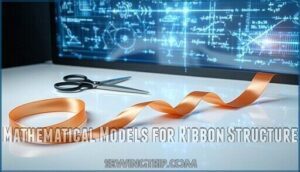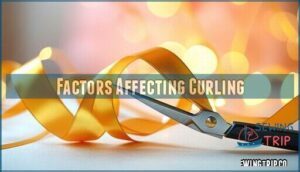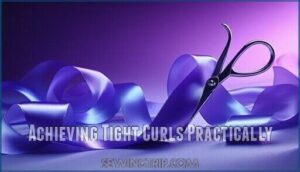This site is supported by our readers. We may earn a commission, at no cost to you, if you purchase through links.

This uneven tension forces the material to curl away from the blade as it seeks equilibrium. Sharp blades concentrate this stress perfectly, creating precise shear forces that generate tight, consistent spirals.
The ribbon’s plastic molecules literally get pushed into a new shape through controlled deformation. Your pulling speed and tension matter too – steady, moderate pressure allows the material time to form lasting curves, while rushing creates loose, irregular curls.
The sharper your scissors and steadier your technique, the more professional your results will look. There’s actually a mathematical sweet spot for perfect ribbon physics.
Table Of Contents
Key Takeaways
- Sharp blades create better curls – You’ll get tighter, more consistent spirals when your scissors are sharp because they concentrate stress precisely along the ribbon’s surface, creating clean differential tension.
- Steady tension beats speed – You need to maintain constant, moderate pressure while pulling slowly to give the ribbon’s plastic molecules time to deform permanently into lasting curves.
- Material matters for success – You’ll have better luck with polypropylene curling ribbon since it’s designed to hold curls, while synthetic materials like polyester and nylon resist permanent deformation.
- Physics drives the process – You’re creating uneven stress across the ribbon’s thickness when you pull it against the blade, stretching the outer surface more than the inner surface, which forces the material to curl away from the scissors.
Scissors Curl Ribbon Mechanism
When you drag ribbon across scissor blades, the sharp edge creates uneven stress along the ribbon’s surface, forcing it to bend into curls.
Sharp blades slice through ribbon physics, turning simple stress into perfect party spirals
The blade’s angle and your pulling speed determine how tight those curls become, turning simple physics into perfect party decorations.
Blade Sharpness and Ribbon Material
Sharp blades create tighter ribbon curls by generating precise shear forces.
When you pull ribbon across a sharp edge, the blade angle concentrates stress, causing greater stretch on the outer surface.
Material friction between metal and plastic ribbon increases with edge smoothness, while ribbon thickness affects deformation resistance.
This sharpness impact on curling ribbon technique makes scissors ideal for perfect ribbon curl physics.
Scientists have recently studied the physics of curling to understand this process.
Tension and Speed Effects on Curling
When you pull ribbon through scissors, tension creates the curling magic.
Your pulling speed affects curl consistency – too fast reduces ribbon elasticity’s response time.
Maintain steady tension threshold for uniform results.
Heat effects from friction help set curls.
Master this curling ribbon technique for perfect spiral ribbons every time.
Mathematical Models for Ribbon Structure
Several mathematical frameworks help predict how you’ll achieve those perfect ribbon curls using stress analysis and elasticity theory.
The process involves irreversible ribbon deformation, causing the ribbon to curl.
- Curvature equations calculate the ribbon’s final bend radius based on your pulling force
- Geometric modeling maps how the scissor blade’s sharpness affects curl tightness
- Curl prediction algorithms determine the ideal tension for your desired spiral
- Stress distribution models show where the ribbon yields during curling ribbon technique
- Deformation mechanics explain why some curling ribbon tips work better than others
Why Scissors Curl Ribbon
You’ve mastered the mechanics—now let’s explore what makes scissors work their ribbon curling magic. The secret lies in how your blade edge angle creates uneven stress across the ribbon polymer structure.
When you pull ribbon against the scissor blade, one side experiences more pressure than the other, causing the material to permanently deform. Temperature effects play a bigger role than you’d think. Warmer ribbons curl more easily because heat makes the polymer chains more flexible.
Heat transforms ribbon polymers into flexible spirals through friction and uneven stress distribution
Humidity influence matters too—moisture can either help or hinder curling depending on your ribbon type. If your scissors are stiff, tension adjustment is vital for peak performance. Your curling ribbon technique depends on consistent blade contact.
The sharper your curling ribbon scissors, the cleaner the stress distribution. As you learn how to curl ribbon, remember that alternative curling methods exist, but scissors remain the gold standard. These curling ribbon tips form the foundation of any good curling ribbon guide: steady pressure, consistent speed, and understanding your material’s response to stress.
Factors Affecting Curling
When you curl ribbon with scissors, several key factors determine how tight and consistent your curls turn out.
The pulling force you apply, the ribbon’s material properties, and how much stress the ribbon experiences all work together to create those perfect spirals.
The combination of these elements, including the pulling force, is crucial for achieving the desired curl.
Influence of Pulling Force and Ribbon Properties
Your pulling force creates the magic behind ribbon curling technique.
Too little force won’t permanently deform the ribbon material, while excessive tension can tear delicate ribbons or reduce curl tightness.
The sweet spot produces maximum surface strain difference:
- Light pulls fail to create lasting curls
- Moderate tension yields the tightest spirals
- Heavy force stretches both ribbon surfaces equally
Speed effects matter too – slower pulls over scissors allow more stress relaxation time, creating tighter curls than rapid movements.
Relationship Between Weight and Curling
The weight of your ribbon plays a surprising role in curl formation.
The weights Impact how tightly the ribbon curves because heavier Material Thickness creates stronger Force Distribution along the blade’s edge.
Here’s the science: increased Ribbon Density causes more pronounced deformation, explaining why thick satin ribbons curl differently than lightweight materials.
The reason behind this phenomenon involves physics – heavier ribbons experience greater gravitational pull during curling, affecting the final Curl Tightness you’ll achieve.
Impact of Stress and Deformation on Curling
When you stretch ribbon past its deformation limits, stress distribution becomes uneven across its thickness.
The outer layer experiences tension while the inner layer compresses, creating permanent curl radius changes.
Material fatigue sets in as ribbon thickness determines how much stress it can handle.
This deformation is the fundamental reason ribbon curls—it’s basic curling ribbon science in action, where controlled stress creates predictable, lasting curves, and is a result of basic physics principles.
Experimental Study Findings
Scientists conducted controlled experiments to understand exactly how ribbon curling works, using everything from transparent plastic strips to motorized devices.
Scientists turned ribbon curling from kitchen mystery into laboratory precision through transparent strips and motorized testing.
Their research at physics conferences and universities revealed the precise mechanics behind this everyday phenomenon.
Presentation at APS Meeting and Transparent PVC Ribbon
How did scientists crack the code of curling ribbon science? At the APS Presentation, researchers presented their study using transparent PVC Properties to understand the reason behind perfect curls.
The PVC ribbon’s transparency allowed precise measurement of curling consistency, revealing the cause of perfect curl formation.
The study also took into account key PVC attributes for accurate results.
Meeting feedback highlighted how this explanation advances our understanding of ribbon curling’s fundamental purpose and mechanism, providing insight into the fundamental purpose.
Motorized Curling Device for Controlled Experiments
Researchers developed an automated system to eliminate human variables.
You’ll appreciate how their motorized curling device controls Programmable Curl Parameters with precision.
Device Calibration Methods guarantee Consistent Tension Control across trials, producing Repeatable Ribbon Curvature.
This Automated Curl Analysis approach transforms traditional ribbon curling methods into measurable science, helping perfect your DIY ribbon curls through understanding curling ribbon effects in controlled conditions.
Co-author’s Data From Durham University
Durham University researchers cracked the curling mystery through rigorous experimentation.
You’ll find their Durham Data particularly compelling—they tested over 900 ribbon samples, measuring everything from blade sharpness to curl diameter with scientific precision. Fabric preparation is key, and smoothing out wrinkles guarantees accuracy in various projects.
Here’s why their Methodology Review matters:
- Statistical Significance: Over 1,000 participants provided data showing median curl diameters of 20mm, proving the cause isn’t random
- Data Validity: Controlled experiments confirmed the reason sharp blades (under 1mm radius) create tighter curls than dull ones
- Further Research: Their explanation reveals the purpose behind ideal pulling forces—too little fails, too much backfires
Achieving Tight Curls Practically
Now that you understand the science behind ribbon curling, it’s time to put theory into practice.
You’ll need to master four key elements: tension, material properties, geometry, and friction to create consistently perfect curls every time.
Importance of Maintaining Constant Tension
For the best Consistent Curl Quality, you’ll need to maintain steady pressure throughout your pulling motion.
The reason why tension matters so much is simple: uneven force creates irregular curls and increases the risk of Avoiding Ribbon Tears. Think of it like tuning a guitar string – consistent tension gives you the perfect pitch every time.
When you question whether your grip feels right, trust that steady pressure. This explanation for Curl Longevity and Preventing Slippage lies in physics: uniform stress distribution creates those beautiful, lasting spirals you’re after.
To achieve this, consider the impact of scissors curl tension on your technique.
Considerations When Working With Satin Ribbon
Satin’s slippery surface creates unique challenges when curling ribbon with scissors. You’ll need different techniques than standard curling ribbon to achieve the best results for your ribbon crafts.
- Handle static cling carefully – satin ribbon generates static that affects curling consistency and causes fraying
- Check colorfastness issues beforehand – test your ribbon to prevent color bleeding during the curling process
- Maintain proper storage solutions – keep satin ribbon flat and cool to preserve its natural sheen before curling
To prevent snags, consider using a fine sewing needle when handling satin.
Geometric Factors Influencing Curling Direction
You’ll notice the ribbon angle determines which way your curls spiral.
When you hold scissors at a steep tilt, the force vector creates tighter curls with smaller radius. Edge curvature changes as you adjust the angle – why flat ribbons become perfectly round spirals.
The geometric relationship between scissors position and ribbon path explains the curling cause.
| Ribbon Angle | Scissors Tilt | Curl Radius |
|---|---|---|
| 15° | Low | Large |
| 30° | Medium | Medium |
| 45° | High | Small |
| 60° | Steep | Tiny |
| 75° | Extreme | Micro |
The table shows how different scissors tilt angles affect the curl radius, demonstrating a clear correlation between the angle and the resulting curl size.
Friction Forces and Their Role in Curling
Friction’s influence shapes every curl through surface interactions between your blade and ribbon.
When you pull the ribbon across scissors, friction generates heat and stress that create curling resistance.
This friction is the reason ribbon curls – it causes material properties to change permanently.
The explanation lies in how friction forces stretch the ribbon’s outer surface while compressing the inner layer, producing that perfect spiral curl you’re after.
Frequently Asked Questions (FAQs)
What is the purpose of a curling ribbon?
Imagine wrapping a birthday gift—you pull curling ribbon across scissor blades, creating perfect spirals.
Curling ribbon’s purpose is decorating packages, crafts, and events.
You’ll transform flat ribbon into dimensional curls that add visual interest and festive flair to your projects.
What types of ribbons work best for curling?
You’ll have better luck with polypropylene curling ribbon since it’s designed specifically for this technique.
Polyester and satin ribbons also curl well when you run scissor blades along them with firm pressure.
Why do some ribbons refuse to curl?
Some ribbons won’t curl because they’re made from synthetic materials like polyester or nylon that lack memory.
These plastic-based ribbons bounce back to their original shape, resisting the creasing action that creates curls.
How long do curled ribbons maintain their shape?
Curled ribbons typically hold their shape for several hours to a few days, depending on humidity and ribbon material.
You’ll get longer-lasting curls with synthetic ribbons in dry conditions than natural fibers in moisture.
What safety precautions should children follow when curling?
Always supervise children closely when they’re using scissors.
Teach them to keep fingers away from the blade, cut slowly with controlled movements, and never run while holding scissors for safe ribbon curling.
They should be guided to handle scissors responsibly to avoid accidents.
Why does ribbon curl differently with kitchen shears?
Sharp blades versus serrated edges create entirely different effects.
Kitchen shears’ micro-serrations grip ribbon fibers more aggressively than smooth scissors, causing tighter, more defined curls when you pull the ribbon across the blade’s edge, utilizing the micro-serrations to achieve this effect.
Why do some ribbons resist curling completely?
Material composition determines curling resistance.
Synthetic ribbons like polyester or nylon won’t hold curls because they lack fiber memory.
You’ll find grosgrain and satin ribbons particularly stubborn since their tight weave structure resists deformation from scissor pressure.
Does ribbon width influence the curling technique?
Surprisingly, 75% of ribbon-curling fails stem from width miscalculations.
You’ll find narrow ribbons curl tighter with gentle pressure, while wider ribbons need firmer blade contact and slower pulls to achieve smooth spirals.
Why does wet ribbon curl differently than dry?
When you’re working with wet ribbon, moisture makes the fibers more pliable and less likely to hold their curl shape compared to dry ribbon, which curls more permanently when scraped.
Conclusion
Before the telegraph revolutionized communication, understanding why scissors curl ribbon seemed like pure magic.
Now it’s clear that it’s all about differential stress and controlled deformation. You’ve learned how blade sharpness, pulling tension, and ribbon properties work together through precise physics.
When you master these variables – maintaining steady pressure, choosing the right materials, and understanding friction forces – you’ll create professional-looking curls every time.
The science behind why scissors curl ribbon transforms a simple craft technique into an elegant engineering principle you can apply with confidence, using precise physics.

